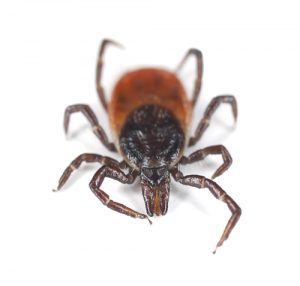Emerging Tick Disease in Our Area
By Chris Williams on June 24, 2011.
ALERT! Just when we have gotten used to Lyme disease (sort of)…now there is another emerging infectious disease and it’s creeping into our area. Babesiosis is a parasitic disease that is spread by the bite of an infected blacklegged or deer tick, the same tick responsible for Lyme disease.
Babesiosis was first diagnosed in Nantucket in 1969 but only recently have the increased number of cases caused concern. Some of this has to do with improved monitoring, reporting, and awareness. Babesiosis occurs mainly in parts of the Northeast and upper Midwest. While the disease is present at some level in all Northeast states, the hotspots for the disease are the various offshore islands of Massachusetts and New York.
 Babesiosis has been called the “Malaria of the Northeast.” Unlike Lyme disease, there is no bull’s eye rash to alert you to the presence of the disease. The good news is that it can be diagnosed with tests and is treatable. For many healthy people, there are no symptoms at all. Others have flu-like or malaria-like symptoms including fever, chills and head and body aches. However, the disease can be fatal for some with weakened immune systems, serious health conditions, or the elderly.
Babesiosis has been called the “Malaria of the Northeast.” Unlike Lyme disease, there is no bull’s eye rash to alert you to the presence of the disease. The good news is that it can be diagnosed with tests and is treatable. For many healthy people, there are no symptoms at all. Others have flu-like or malaria-like symptoms including fever, chills and head and body aches. However, the disease can be fatal for some with weakened immune systems, serious health conditions, or the elderly.
The incidence of babesiosis peaks from May to August when ticks are most active. A blacklegged tick infected with babesiosis usually must feed for more than 24 hours in order to spread the disease, so early detection is critical. Symptoms usually develop within a few weeks, but can take months. To protect yourself and your family, follow the same procedures that you use now to prevent tick bites:
1) Minimize exposed skin – Wear socks, long pants, and a long-sleeved shirt.
2) Use repellent – Apply a personal repellent containing DEET to skin and clothing when outdoors, especially in wooded, brushy or grassy areas. Permethrin products can also be used to treat clothing.
3) Stay on cleared trails – Avoid edge areas and contact with leaf litter, brush, and tall grasses where ticks are found.
4) Check for ticks – Once inside, conduct a full body check using a mirror to check all parts. Then shower or bathe to remove unattached ticks.
5) Remove any attached ticks – Use tweezers and a gentle pull, holding the tick near the mouthparts.
6) Follow-up – See your physician if any rash, fever, or aches develop.